Book Review: “NO MILK” by Daniel A. Twogood
Milk and other allergens and additives in our food can cause neck pain, back pain, and headaches. As shown by a case study with 3,000 patients.
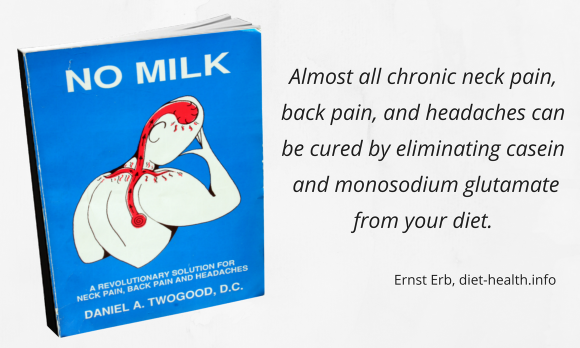
Table of contents
Conclusion
Allergens and poisons can be the cause of many chronic diseases. If you have a health condition and your doctor/practitioner has been unable to determine its cause, try to experiment with your diet to identify any potential allergens. It is also important to watch for any additives that your body might react to.
The author and I (as a physician) are aware of the fact that the amount of scientific evidence at 3'000 cases is not very large to confirm the claims laid down in this book. The reasons for this are manifold; it is a complex subject that requires interdisciplinary collaboration with physiologists, biochemists, nutritionists, and other medical experts. And the very powerful and influential dairy lobby makes it difficult to gain the necessary funding and is the reason for the lack of clear evidence-based findings.
It is also likely that many patients went to see Dr. Daniel A. Twogood only after other methods were of no avail. This explains the extremely high cure rate.
The author does not address all of the problems concerning milk, but instead focuses only on the allergens.
To obtain comprehensive information about the health problems caused by milk and dairy products, we recommend the book "Milch, besser nicht!" (Milk, better not!) by Maria Rollinger — or at least the book review of it on our site.
1. Summary
Dr. Daniel A. Twogood treated 3'000 clients in his practice over a period of six years.
The author works as a chiropractor in a private practice in California. Chiropractors address functional, reversible disorders of the musculoskeletal system, which are commonly referred to as muscle tension.
The author came upon the “milk connection” when a patient who had meticulously examined his own eating habits related that his neck pain, back pain, and headaches occurred regularly after he consumed milk or dairy products. In the course of his observations (comparable to a hypothetical prospective cohort study), Dr. Daniel A. Twogood came to the conclusion that casein, a milk protein, can trigger an allergic reaction that includes various symptoms such as chronic musculoskeletal pain, digestive problems, and behavioral problems.
He went a step further and wrote:
In my opinion, eliminating animal products from the diet is probably the single most powerful health inducing dietary change a person can make. However, many vegetarian programs rely on soy products heavily. So allergy can commonly result (p.138).
Blurb and about the author
Dr. Daniel A. Twogood graduated from the University of California at Santa Barbara with a degree in Kinesiology. He attended Cleveland Chiropractic College in Los Angeles, where he graduated in 1983.
After practicing at the International Sports Medicine Institute in West Los Angeles, he opened his own practice in Apple Valley, California.
Here he met a patient who told him that his own back pain and headaches were caused by certain foods in the diet, namely milk and dairy products. This book is the result of six years of checking out this patient’s story in Dr. Twogood’s clinical experience as a chiropractor.
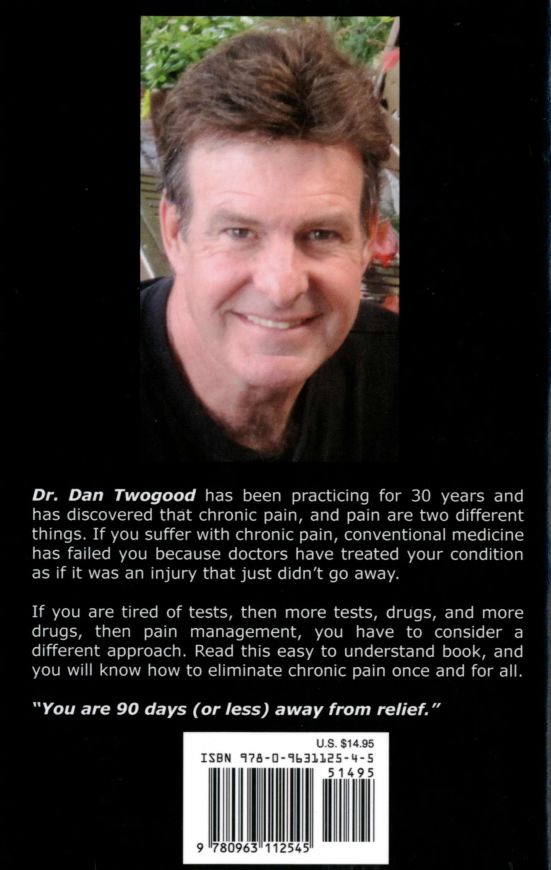 | Dr. Dan A. Twogood is a chiropractor in Apple Valley, California. He studied at the University of California, where he graduated in 1973 with a degree in sports and physical education. He then attended the Cleveland Chiropractic College and received his doctorate with magna cum laude in 1983. Following that (in 1984) he started to work at the International Sports Medicine Institute in West Los Angeles. |
Some of the patients he treated there were athletes in the Summer Olympic Games at the time. In 1985 he opened his own practice in Apple Valley, California, and that is where he discovered the connection between milk and pain.
Dr. Twogood is the author of four books on chronic pain:
- No Milk (1991),
- How To Rid Your Body Of Pain (1996),
- MSG Is Everywhere (1997),
- and his latest work so far, Chronic Pain Gone 90 Days.
He is available for interviews and public lectures. (The Independent Author Network)
2. Book review
Most people are not aware of the fact that over 50 % of the diseases we suffer can be traced back to our diet. Hippocrates used to say that the key to a healthy life is having the most natural and healthy lifestyle possible.
2.1. The Cause of Disease p. 24
Even today, physicians swear by the Hippocratic Oath, promising to do everything in their power not to harm patients.
Instead of doing a thorough anamnesis (survey of medical history) as part of the first visit, which would also provide insight into a patient’s eating habits, doctors today are primarily concerned with making a quick diagnosis. This is probably a result of their conventional medical training and the pressure put upon them to be quick and efficient. Certainly, careful instrumental examinations such as blood samples, X-rays, computed tomography (CT scans), and magnetic resonance imaging are also important means for determining a patient’s condition.
Once the diagnosis has been made, physicians practicing conventional medicine, particularly in the non-surgical disciplines, usually recommend a treatment of medications.
Hereditary diseases, traumas, infections caused by pathogens, ingested allergens, poisons, and unknown causes (idiopathy) are considered harmful to health. Medicine is not always able to determine the reasons for a disease.
The knowledge acquired in health and medicine has often been arrived at through trial and error. Physicians who practice conventional medicine sometimes give the impression that they view the human body as a chemical playground
(p. 26).
Drugs, working as potential toxins, further irritate the system (body)
Since Paracelsus we have known that adding a chemical into the bloodstream will manipulate or alter physical symptoms. But it can also cause side effects.
In his fourth book titled "Chronic Pain Gone 90 Days" (Chapter: Just Say No To Drugs, p. 28ff, see image below), Dr. Daniel A. Twogood contends that drugs, working as potential toxins, further irritate the system (= body). And this is a system that is already out of balance.
The author is aware of the fact that there has been an increase in cancer since the beginning of the 20th century — and that this has been in spite of modern medicine.
How is it that heart disease hardly occurred in the 19th century, but that today it’s one of the most common health conditions? Was this a result of the lack of diagnostics, the smaller number of physicians, more infrequent doctor visits, less thorough documentation, and/or statistics?
Based on his experience, observations, study of relevant published works, and subsequent deduction
(p. 31), Dr. Daniel A. Twogood concluded that casein is the main cause of neck pain, back pain and headaches.
This is a conclusion that may appear less significant given the lack of evidence-based, double-blind studies. But in spite of the sparse data, the author points to numerous examples and Internet discussions on the topic.
Moreover, this thesis shouldn’t be categorically rejected before more trials are conducted. According to the author, many health problems are caused by milk, even if not everyone is allergic to it.
In 1985, Dr. Daniel A. Twogood began to consider approaches used in bioecology. This after he learned from one of his patients that the patient had cut out all milk and dairy products and was no longer suffering from headaches, neck pain, or back pain.
The story of Robert Ester
Robert Ester, mid-fifties, had seen many different doctors and specialists for his severe headaches, neck pain, and back pain, but even though they did countless tests and examinations, none of them could find the cause of his pain. Each of the practitioners had their own assumptions as to the cause and prescribed an appropriate treatment, but none of these were successful.
Then one day two of the doctors pointed out that he had slightly elevated cholesterol levels in his blood, but also said that this had nothing to do with his symptoms. Nevertheless, he decided to make changes to his diet. To curb cholesterol intake, he abstained from red meat, eggs, fats, dairy products, and sweets.
And what do you know, the pain was gone after just a few weeks. He was still uncertain as to which of these foods had been the cause.
About four months after he had changed his diet, he had a craving for a glass of milk. When the milk touched his lips, he immediately felt a burning sensation along his spine. And just a little later he a got a very bad headache. After that, he exposed himself to milk (or dairy products) another 25 times, each time with the same result.
Until 1985, Dr. Daniel A. Twogood assumed that headaches, neck pain, and back pain were the result of trauma to the spine. Structural changes result in physiological changes, which in turn produce symptoms (p. 32). By manipulating the affected parts of the bony structure, chiropractors can reverse traumatic changes. Chiropractic philosophy dictates that the cause of these symptoms is determined … then eliminated
(p. 32).
Physicians and chiropractors
Physicians, however, try to eliminate symptoms and diseases through controlled chemical and structural changes, in other words, medication or surgery. If the symptoms are caused by inflammation, the treatment of choice is anti-inflammatory agents, such as NSAIDs (Non-steroidal anti-inflammatory drugs). If there are any additional muscle spasms, doctors prescribe a muscle relaxant.
Pharmaceutical companies are working day and night to develop chemicals that can effectively reverse, or shut down, unpleasant symptoms (p. 32).
If the structural changes are too serious or cannot be reversed, doctors may try to correct the problem surgically.
Chiropractors try to prevent certain symptoms by manipulating bony structures. For example, a subluxation (partial dislocation of a joint) can cause a certain symptom. The chiropractor prevents the symptom by correcting the partial dislocation of the joint.
A healthy person, who otherwise would have developed health problems because of the subluxation, doesn’t have to suffer from the condition. Prevention is the name of the game
(p. 33).
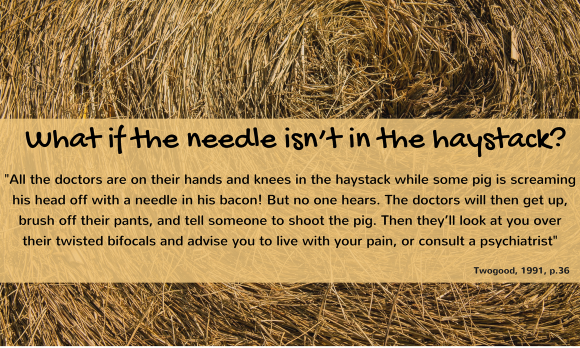
Another problem is that many patients have already seen several doctors for their chronic symptoms (such as general practitioners, specialists, and other experts at hospitals), received multiple diagnoses, and endured a lot of treatments without experiencing any improvement. Many of these will seek out further doctors or alternative medical practitioners to finally find relief.
Spinal manipulation
Spinal manipulation is an effective method offered within the health system.
Before Dr. Daniel A. Twogood devoted himself to bioecology (i.e., the science of how the human body reacts to environmental influences), he was a traditional chiropractor who achieved good results using spinal manipulation. However, he was by no means able to heal all of his patients. Patients who did not respond to his treatment were usually put back on medication or had surgery.
If chiropractic fails as a conservative form of treatment and orthopedists and neurologists are at a loss, then generally more tests will be done. These are designed to find the needle in the haystack. But what if the needle isn’t in the haystack?
If the needle is in the pig’s trough, further tests won’t result in answers either, and the process will head in the wrong direction (p. 36).
Dr. Daniel A. Twogood believes that patients should always consider bioecological approaches prior to surgery and/or treatment with medications.
The author therefore presents his thesis that cow’s milk is not good food. Milk is a terrible food. Milk does not do a body good. Milk causes all by itself, more damage than any other supposed health food on the market. Milk is not good for kids, or adults. Cow’s milk is designed for, and only good for … baby cows!
(p. 42)
[Physicians] want to hear something that fits comfortably into their beliefs. This notion doesn’t, so it is easily discounted.
(p. 47)
"All things are poison and nothing is without poison; the quantity alone determines if a thing is not a poison"
In both medical and chiropractic school, there are poor students who become poor practitioners. That’s not the problem. We need new ideas and treatment approaches, especially for those patients who don’t experience any improvement in their condition after being treated by conventional practitioners.

During my medical studies at the University of Basel (Switzerland), I was taught that not eating cheese reduces susceptibility to migraines and abstaining from chocolate has a positive effect on the complexion in terms of acne. This connection was already suspected even back then, which is why it is obvious that practitioners (including myself) would advise their patients to avoid cheese or chocolate, for example, if they were suffering from migraines or acne.
However, not everyone reacts to allergens.
Only after a person develops a sensitivity, will any exposure to the allergen bring about an allergic reaction. And even small amounts of an allergen can trigger symptoms.
Toxins, however, are toxic for everybody. It is the quantity that matters. Paracelsus said: “All things are poison and nothing is without poison; the quantity alone determines if a thing is not a poison.”
The fact that Dr. Daniel A. Twogood was able to show that joint and muscle problems can be triggered by milk (and dairy products), other common allergens, and poisons amazes me. I remember from my studies and working in a hospital that lifestyle modifications (= changes in lifestyle, e.g., weight loss, reduction in blood pressure and blood lipid levels, and adherence to a diet to regulate blood sugar levels) were recommended as a therapeutic approach, in particular, for metabolic syndrome.
If a patient was referred to us for further tests by a general physician for chronic joint symptoms, but the referral did not list obesity, hypertension, high lipid levels, or "insulinresistance" as factors, the procedure was as follows:
- medical history (anamnesis) to find out whether an acute trauma was present or if there was evidence for the overuse of a joint.
- this was followed by a blood sample to determine changes in the blood (for example infection/inflammation)
- finally medical imaging, which was generally a CT or MRI because of the better resolution.
A diagnosis could usually be made based on the above findings, which in most cases involved treatment with medication as Dr. Daniel A. Twogood describes in his book. In my experience, any steps taken to have the patient make diet changes played a minor role. An exception was metabolic syndrome as described above.
2.2. The Milk Connection p. 50
In the case of a milk allergy, even small amounts of casein can cause headaches, neck pain, and/or back pain, which can last three to four days on average. If, for example, a person suffering from this allergy has cereal with milk at the beginning of the week, some cheese on Wednesday, and pancakes on the weekend, then that would be enough to cause them to suffer symptoms every day of the week.
A person who is allergic to "penicillinum" does not get told to just take less "penicill.." from now on. It is listed on their medical information card or Medic Alert wristband that they may not receive "penicill.." antibiotics under any circumstances (p. 76).
Other allergens that often lead to sensitivities (or hypersensitivities) include chocolate, ice cream, and sour cream. Milk chocolate, for example, contains cocoa, milk, sugar, and theobromine, with the latter being a stimulant. Theobromine is chemically similar to caffeine. If you believe that it is milk chocolate specifically that triggers sensitivities, you are mistaken.
Dr. Daniel A. Twogood therefore advises against consuming milk and chocolate.
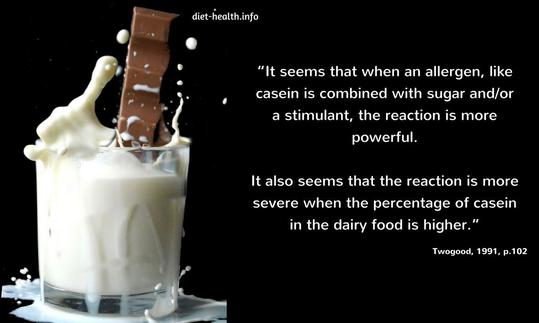
Many people think that physical suffering is an unavoidable part of getting older and just put up with it (p. 81). It could be the consequences of continued milk consumption in the presence of a milk allergy that has gone undiagnosed. So why not just cut out all dairy products for a while and see whether or not you experience an improvement?
Symptoms such as neck pain, back pain, and headaches should be listed in medical books as characteristic for allergic reactions to foods, mainly dairy products
The author’s interest in the subject was sparked by a patient who observed that consuming dairy products caused him to have back pain and headaches.
In the following six years, Dr. Daniel A. Twogood was able to establish this connection between the consumption of milk and dairy products and back pain, neck pain, and headaches in an additional 3'000 patients (pp. 51 and 97).
It should be emphasized again that this is anecdotal evidence, which in contrast to empirical evidence still does not allow for a conclusion by analogy to be made. However, it forms a good basis for further studies to confirm the above thesis (evidence-based medicine).
Dr. Daniel A. Twogood even goes so far as to state that symptoms such as neck pain, back pain, and headaches should be listed in medical books as pathognomonic, or characteristic, for allergic reactions to foods, mainly dairy products
(p. 50).
Crepitus [grating/crackling of the joints] is not present in every case of milk allergy. In my experience, crepitus is present in 75 % of cases where symptoms are due to milk allergy. But, crepitus will disappear in 99 % of cases when casein is totally eliminated from the diet
(p. 177).
Casein is the number one cause of back pain, neck pain and headaches. In my experience, casein causes these symptoms in 95 % of cases. … Believe it or not, the other 5 % of these cases are caused, usually, by other dietary poisons, or allergens,
for example, monosodium glutamate (p. 113).
Allergy can manifest itself as joint and muscle pain, heart palpitations, drowsiness, mood changes, hyperactivity, muscle cramping, etc. Allergy can be an abnormality in the human condition. Allergy can cause antisocial behavior. Allergy can change your handwriting. (p. 59)
Food intolerances and allergies are more common in our society than some of us, including doctors, might suspect. A breast-fed infant can develop an allergy to cow’s milk through the dairy products consumed by the mother, who passes the casein on to her baby through her milk without the baby ever having any direct contact.
"Milk, The Deadly Poison" by Robert Cohen"
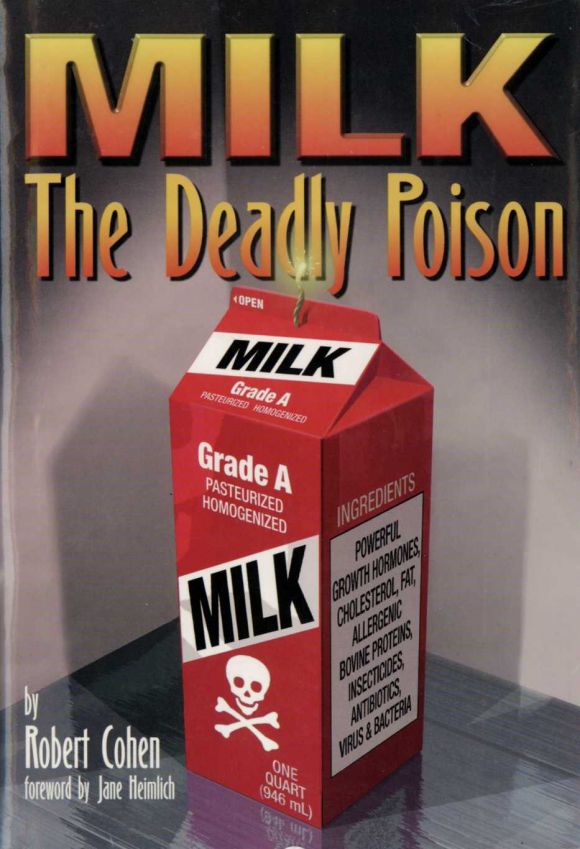 | But why does the food industry claim that milk and dairy products are important and healthy? Why is milk consumption not questioned by the medical profession? When patients say, I want to eliminate milk and dairy products completely from my diet, their doctors usually answer with something like the following: Where will you get the calcium necessary for bone health, if not from milk? |
If you consider that cow’s milk is actually only designed to feed calves, then why does it seem like dairy products are something we can’t do without today and why are they touted to be especially healthy for us?
If you are interested in these questions and related issues, I recommend the book "Milk, The Deadly Poison" by Robert Cohen, or our book review of it, which you can find here.
Both cow’s milk and breast milk contain lactose, which is a disaccharide consisting of the usable sugars glucose and galactose. Lactase is the enzyme required to break lactose down and further process it.
If the body can no longer break down lactose into glucose and galactose because of a lack of lactase, the undigested lactose (carbohydrate) collects in the interior of the bowels, where colonic bacteria ferment it to lactate, which causes bloating. In addition, this leads to an osmotic diarrhea. This means that food components that were not absorbed osmotically draw water into the intestines, which then produces diarrhea.
Lactase levels in the small intestine are highest immediately after birth so that the infant can efficiently metabolize the lactose supplied to him/her through the breast milk.
The human body is designed to drink milk only during the first months of life. Our body seems to inherently know how long the milk is good for it. However, our society and modern medicine have redesigned this process for the purpose of convenience.
Allergies are not something children grow out of, but instead they remain with a person for a lifetime
We too often forget that toddlers who were switched over to cow’s milk end up suffering from abdominal bloating, diarrhea, colitis, skin rashes, and restlessness because of an allergy to cow's milk.
Some doctors believe allergies are a childhood phenomenon and that they disappear as children grow older. Dr. Daniel A. Twogood disagrees.
Although the (allergy) symptoms often seem to disappear around the fifth or sixth year of life (= masking, concealment), many of these patients consult me in adolescence or adulthood, with headaches, or back pain, that is, in fact, due to their milk allergy
(p. 86).
For infants and toddlers, a milk allergy usually manifests itself first as digestive and skin problems, later as recurrent streptococcal infections in the ear, nose, and throat area, and as adolescents in the form of learning/behavioral problems, joint pain, and acne (p. 175).
Allergies are not something children grow out of, but instead they remain with a person for a lifetime. It is therefore doubly surprising that many children have a special milk break at school or receive milk at lunch!
The AMA (American Medical Association) and the dairy industry in this country have determined we need 1'000 to 1'500 milligrams of dietary calcium per day to maintain optimum health. The best source for calcium, they claim, is milk and dairy products. (p. 72)
Asian and African people do not consume milk and have a daily calcium intake of less than 400 milligrams a day, yet they have healthy teeth and do not suffer from osteoporosis. (p. 72)
Calcium absorption in the small intestine depends on the ratio of calcium to phosphate (Ca/Ph ratio) and also the protein content of the food ingested. If the protein content of the food is too high, the liver breaks down the surplus to urea and nitrogen compounds, which are then excreted by the kidney. Urea has a diuretic effect, and as a result more electrolytes are lost, including calcium.
Cow’s milk has a Ca/Ph ratio of 1:2 and contains more protein than breast milk which has a Ca/Ph ratio of 2:1. One liter of cow’s milk contains about 1'200 mg of calcium whereas one liter of breast milk contains only 300 mg. Thanks to the “better” calcium-phosphate ratio and the lower protein content of breast milk, the infant receives more calcium from breast milk than cow’s milk.
"Drinking milk for calcium makes about as much sense as smoking for weight control"
At the bottom of page 72, Twogood writes: Drinking milk for calcium makes about as much sense as smoking for weight control.
The facts about calcium are these: humans can get all the calcium they need for optimum health from a normal diet of vegetables, fruits, rice and beans. Cows produce lots of calcium without drinking milk. Cows are vegetarians. Calcium deficiency of dietary origin is unknown in humans
(p. 73). The medical community has not yet considered that a calcium deficiency could be caused by poor eating habits!
Cow’s milk contains the following proteins: casein, lactalbumin, and lactoglobulin, whereby casein accounts for 77 % of the total protein. Milk consists of a solid component, the curd, and a liquid part, called whey.
The production of cheese requires only the solid component; the remaining whey is a waste product. Cheese contains primarily the protein casein. The lactalbumins and globulins remain in the whey. Some people with a milk allergy do not react to whey products because as they do not contain casein, which causes milk allergies. This was also the case for the author’s patients (pp. 73, 84).
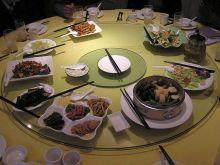 | There are many different types of diets and food traditions. In China, round tables are popular as they allow people to easily share the food. This photo shows a table with a rotating glass surface. Image: Invitation from Chinese collectors and friends in China. |
Many people are aware that milk isn’t good for them as they experience flatulence and diarrhea after consuming it. This is the result of a lactose intolerance, which is caused by a deficiency of lactase in the intestine. Since lactose intolerance is a common problem, the food industry responded promptly and introduced lactose-free products to the market. But even that will not necessarily counteract a milk allergy since casein occurs in milk with the same concentration.
The author writes, It amazes me that milk is still considered the ‘perfect food.’ The dairy industry is pushing new products because the fat content of their ‘perfect food’ is too high and is one of the main contributors to heart disease, the number one health problem in our country. They want people who throw up milk or get stomach cramps to keep drinking the stuff by taking a pill after each dose.
The dairy industry and other social pressures have convinced mothers to pull their newborns from their breasts at earlier and earlier ages so mom can get on with a job, or life, or just away from the baby (p. 74).
Although the food industry has adjusted the fat and lactose content of milk, the allergy problem remains since casein remains the cause.
You may be consuming dairy products on a regular basis without realizing it
The dairy industry will therefore likely continue to optimize their “perfect food.” We, however, should finally realize that milk fat, lactose, and casein are not good for the human body.
Since most people know that dairy products are unhealthy because of their high fat content, they make an effort to consume only skim milk products, something that is also recommended and endorsed by doctors. Many think that by consuming skim milk products the problem is solved, but this is only true if the goal was to reduce the fat content.
If a person is suffering from chronic headaches, neck pain, and/or back pain as a result of a milk allergy; then the symptoms will disappear only after they completely eliminate milk from their diet.
If you look closer at the products at the grocery store, you will see that dairy products are added to a lot of ready-made, pre-packaged foods. Even if you don’t think you consume milk (e.g., milk straight, milk in your coffee/tea or on your cereal, cheese, and pudding), you may be consuming dairy products on a regular basis without realizing it. And, as Dr. Daniel A. Twogood maintains, casein is the main cause of his patients’ symptoms.

We are slaves of milk! However, it is not so easy to completely eliminate dairy products from our diet today. The food industry has known for some time now that we crave creamy foods, and they therefore add milk derivatives such as sodium caseinate to many food products.
Milk substitutes are on the market that are supposedly made without any dairy products.
It is not surprising that so many people continue to consume milk and dairy products in good faith. After all, these products provided for us by the food industry can’t really be that bad or harmful.
If you want to eliminate allergy symptoms caused by milk consumption, you must completely cut out casein from your diet. The symptoms will then disappear within 7 to 30 days. In the first week after complete abstinence from casein, some people experience certain withdrawal symptoms, especially a headache on the third day (p. 110, points 1–3).
If a person is sensitive to a particular ingredient, they may experience withdrawal symptoms once they omit it from their diet. The phenomenon of allergy-addiction (p. 107f) usually occurs in the form of intense desire or craving for the ingredient.
2.3. Beyond Milk: Other Allergens and Poisons p. 119
Dr. Daniel A. Twogood takes it a step further and blames the standard American diet (also meat-sweet diet or Western pattern diet) as the cause for cancer and other diseases. Most people are becoming increasingly aware of the health risks posed by specific substances that they unknowingly ingest every day.
The general public is aware of the risks associated with the standard American diet, and yet hardly anyone knows exactly where and how often specific substances such as monosodium glutamate (MSG) are used. We are neither ignorant nor stupid, but victims of our own credulity. Supposed experts outwit and lead us astray. See also Salt, Sugar, Fat by Michael Moss.
"Salt, Sugar, Fat" by Michael Moss
 | It is a known fact that heart problems are on the rise in industrialized countries, and that this is attributable to our poor diet (Western pattern diet). And cow’s milk contains high levels of fat and cholesterol. The dairy industry knows this and has therefore put much effort into developing new products that have a reduced fat content. |
The trend has been increasingly toward consumption of products with reduced fat and sugar.
But at the same time there has also been an increase in the consumption of cheese, which has a much higher proportion of casein, and of convenience foods that contain cheese.
After all, it contains so much calcium, which protects us against osteoporosis. What a misconception!
You can read more about how the industry accomplishes this in our book review of "Salt, Sugar, Fat" by Michael Moss.
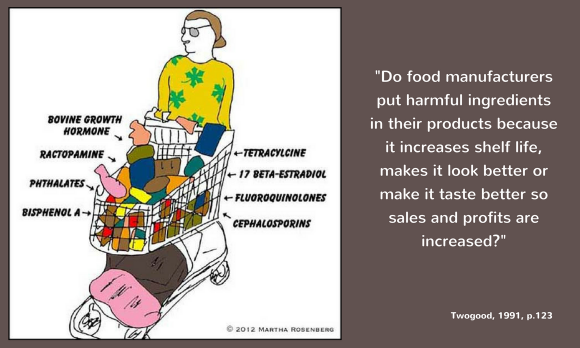
It is beyond our comprehension that the food industry can no longer do without additives. Perhaps some of us are familiar with monosodium glutamate (MSG) in connection with the “Chinese restaurant syndrome,” which is slang for glutamate intolerance.
We are generally aware of the health risks of our eating habits, but that does not stop the food industry from designing more products that taste good and sell good.
99 % of all headaches will be solved by eliminating monosodium glutamate (MSG) and casein
Monosodium glutamate (MSG) is composed of sodium and glutamate, the salt of glutamic acid, an amino acid.
Glutamate is a neurotransmitter (chemical messenger) with an exciting/stimulating effect. The food industry knows that the natural production of flavor enhancers is costly. And natural flavor enhancers do not have the addictive effect that monosodium glutamate (MSG) has (p. 124). It is therefore not surprising that some people downright crave Chinese food!
Food manufacturers have learned to work around the labeling guidelines of the FDA (Food and Drug Administration), so they can continue to use MSG – even though they know it’s poison! (p. 124).
And as a result, you may, for example, find the following on the packaging: “contains hydrolyzed (vegetable) protein,” which is nothing other than MSG.
A lot of convenience products include “natural flavorings,” which are used to regulate and stabilize the consistency, taste, color, and shelf life of processed foods.
Look at all the other ingredients that could have serious consequences for people who are sensitive, say to eggs or yeast. … It seems that food labeling, initially designed to inform people, has been twisted around by food manufacturers to mislead people (p.125).
In 1969, the use of monosodium glutamate was banned in infant baby food.
Monosodium glutamate is a poison that affects all people, some more than others, depending on sensitivity. Poisons are dose dependent, so more MSG will cause more severe symptoms. (p. 129)
In fact, 99 % of all headaches will be solved by eliminating MSG and casein. (p.130)
The author lists out other common food allergens by frequency (which incidentally are consumed most often in developed countries). They are as follows: wheat, corn, soy, eggs, coffee, and cane sugar (p.138).
The gluten contained in wheat (which consists of several proteins, including glutenin and gliadin), triggers inflammation in the small intestine if a person suffers from gluten intolerance (gluten sensitivity). The mucous membrane can then no longer absorb nutrients as well. These remain undigested in the intestines, which can lead to symptoms such as diarrhea, vomiting, loss of appetite, and depression. Headaches, and muscle and joint pain occur frequently with gluten intolerance.
2.4. The Symptoms p. 174
Dr. Daniel A. Twogood concludes that allergens can potentially enter any other organ through the bloodstream — including the nervous system — and trigger other diseases there. The resulting symptoms are varied and can occur anywhere. Sometimes the symptoms tend to move or affect only one side of the body or one limb.
Carpal tunnel syndrome, multiple sclerosis, headaches and cancer
When an allergen (e.g., casein in milk) or potential toxin (e.g., monosodium glutamate in processed food) affects an organ, it causes swelling of the tissue. For example, in the nerve and muscle passage of the hand, called the carpal tunnel, the allergen may trigger swelling of the median nerve. This can result in paresthesias (abnormal sensations) and/or pain of the limbs, which is known as carpal tunnel syndrome.
Conventional medicine assumes that overuse of the hand results in scar tissue in the carpal tunnel, which then impairs the median nerve. The problem is therefore often addressed surgically, which leads to more scar tissue in the carpal tunnel. As a result, therapeutic successes are not common.
In multiple sclerosis, an autoimmune disease, the myelin sheaths (myelin = electrically insulating outer layer) of the nerve fibers are attacked. The sclerotic lesions are incurable, affect nerve conduction, and lead to difficulty with walking, swallowing, and body coordination.
Dr. Daniel A. Twogood notes that headaches may be the result of exposure to an allergen and/or toxin or the result of withdrawal (allergy addiction) (p. 184). The wave of fatigue we feel after eating a meal can also be caused by a milk allergy (p. 187).
We could begin by collecting information about the dietary habits of cancer patients and analyzing this for similarities since continued exposure to allergens strains the body and can lead to cancer (p.190).
Sometimes a disease can become so elusive for the doctor and the patient that a mental abnormality arises, which is in fact caused by the allergy. Although doctors are aware that nerves can be irritated both physically and chemically, they usually only take physical causes into consideration, even if there has been no physical trauma in the patient’s medical history.
Food manufacturers still consider the following to be a healthy breakfast: sweetened 7-grain crunch cereal, possibly with raisins and sweetened and crispy cornflakes, both served with milk or yogurt.
Erb Muesli on the other hand is truly a healthy option. It has never included dairy products, in contrast to Bircher muesli. It contains grains low in gluten (oats, barley) and/or gluten-free grains (teff, millet). In the original recipe, these were sprouted for 24 hours.
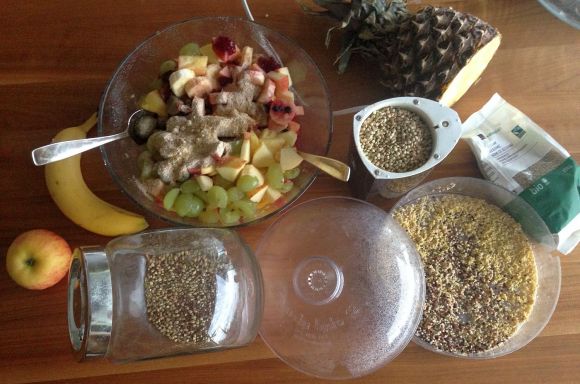
2.5. The Stories p. 192
The author takes 20 pages to share 20 testimonials with the readers. Both sexes are represented. The youngest patient is 13, the oldest 72 years old.
The medical histories of some of the patients
The medical histories of some of the patients are somewhat shocking.
For example, one 49-year-old woman had surgery for carpal tunnel syndrome in her right hand. After that, she had even more pain, so they wanted to correct that and then perform surgery on the other hand as well (more information on this syndrome is provided several sections above).
She refused to do so and a year later ended up with an orthopedist, who diagnosed a thoracic outlet syndrome (TOS), which is a neurovascular compression syndrome (crush syndrome). Then the doctors wanted to remove a rib and cut some nerves. The patient however decided that she would rather live with the pain and took a dose of Clinerol daily.
It sounds like a fairy tale, but the reports are very detailed and professional.
It is amazing that some of these patients stood out who had a particular high consumption of milk and/or dairy products. Some had constant headaches that were so bad that they regularly took pain relievers. But there were also patients who, for example, only consumed butter (milk fat) or who only ate cheese every now and then.
In one case, a 58-year-old man ate a cheese sandwich after a month of abstinence from any dairy products, and the pain set in within 20 minutes and lasted for four days. He had severe arthritis (p. 197).
It is interesting that in some cases a trauma such as a whiplash preceded the onset of pain caused by milk consumption. This pain sometimes persisted for years and only the full elimination of dairy products including foods that contain dairy products (such as pizza), finally brought relief from the pain.
Dr. Daniel A. Twogood also takes up three cases of additional ENT (ears nose throat) problems.
A 62-year-old woman came to see him because of a chronic stiff neck, headaches, and noise that occurred when she turned her head. The anamnesis (medical history) also revealed chronic nasal congestion. She had sinus problems and suffered from a chronic sinus infection (sinusitis). She drank two glasses of skim milk a day and ate cheese and other dairy products almost every day.
A 16-year-old teenager saw the author for back problems. She mentioned that she also had nausea and digestive problems. Her father said that she often suffered from streptococcal infections and tonsillitis. Both said that she was very moody and often felt tired. She had milk on her cereal only about once a week, but loved her daily cheese and “of course” chocolate now and then. She got chocolate milk (hot chocolate) daily at school. That only turned up when the author and patient discussed her usual daily routine in detail as part of an interview.
The girl managed to give up milk, chocolate, and other dairy products. Results already started to show after a week. After two or three weeks, she no longer suffered from back pain, fatigue, or nausea. And she didn’t get any more infections.
A 72-year-old woman was seen for neck stiffness and discomfort between the shoulder blades. But then during the anamnesis, she explained other problems she suffered from, including numbness in the hands and feet, chronic nasal congestion, and “weak feet.” The doctors had suggested surgery for carpal tunnel syndrome, which she refused.
After eliminating dairy products from her diet, the symptoms disappeared just a week later. Pauline had suffered for 30 years, and the problems cleared up after just a few days.
Headaches, neck pain, and/or lower back pain constitute the vast majority of the cases.
Once dairy products were fully eliminated from their diet, most of the pain disappeared within two to four days.
With occasional ice cream consumption, the pain again set in only two days later. The author writes of several patients who thought that they would be able to eat dairy products again later or did not believe in the effectiveness of the treatment, and instead thought it was the result of the chiropractic treatment.
Dr. Daniel A. Twogood also takes up three cases of additional ENT (ears nose throat) problems.
The author emphasizes that particularly in the elderly — but not only — it could take up to 30 days for the problems to disappear.
2.6. Prescription for Health p. 213
It seems that as people get older, they choose to eat fewer treats and goodies because they are more aware of the risks that go along with consuming such foods. But the youth in industrialized countries has little interest in doing without their treats. Today’s average family can afford a lot of luxuries, although both parents often work to do so. As a result, children and teens are unsupervised at home and help themselves to all kinds of junk food (p. 215).
The key to a healthy life is to have the most natural and healthy lifestyle possible.
For example, Wikipedia (Nov. 2014) recommends that as part of a whole foods diet, grain products, milk, and dairy products should be consumed every day.
Incidentally, milk and bread have changed greatly since the Second World War, starting at the level of the farm (seeds, artificial fertilizers, pesticides, animal selection, livestock breeding, and animal feed). If you want to have fewer symptoms and get rid of pain, you should try to avoid allergens and toxins as well as stimulants and sedatives.
2.7. Last Word p. 248
Although most diseases are caused by diet, many people do not yet believe this fact. It would be best if the milk industry were banned from advertising dairy products as a healthy staple food. Many publications and studies show that cow’s milk is indeed one of the unhealthiest foods for humans.
3. About the book
| Title | NO MILK |
| Subtitle | A Revolutionary Solution for Neck Pain, Back Pain and Headaches |
| Author | Daniel A. Twogood, D.C. |
| Publisher | Wilhelmina Books, P.O. Box SVL 8354, Victorville, California |
| Publ. date | 1991 |
| Pages | 261 |
| ISBN | 0-9631125-0-3 |
| Comments | In addition to milk, the author also discusses other possible allergens and toxins that can cause chronic pain. D.C. stands for Doctor of Chiropractic. |
Sources p. 253
- Colbin, Annemarie; "Food and Healing", Ballantine Books, N.Y. 1986
- Foreman, Robert; "How to Control Your Allergies", Larchmont Books, Atlanta, Georgia, 1984
- Hunter, Beatrice Trum; "Gluten Intolerance", Keats Publishing, New Canaan, Connecticut, 1987
- Mandell, Marshall; "Dr. Mandell’s 5-Day Allergy Relief System", Pocket Books, N.Y. 1979
- McDougall, John A. and Mary A., "The McDougall Plan", New Win Publishing, Clinton, N.J. 1983
- Oski, Frank; "Don’t Drink your Milk", Mollica Press, Syracuse, N.Y. 1983
- Schwartz, George R.; "In Bad Taste, The MSG Syndrome", Signet, a division of Penguin Books, N.Y. 1988
- Winter, Ruth; "Poisons in Your Food", Crown Publishers Inc, N.Y. 1991
- Keyes, Ken; "Prescription for Happiness", Love Line Books, OR 1986
- Robbins, John; "Diet for a New America", Stillpoint Publishing, Walpole, NH, 1987
- Robbins, John; "Animal Agriculture and the Water Crysis", The Animals’ Voice, Volume 4, Number 2, April/May 1991
- Klaper, Michael M.D.; "The Real High Cost of Meat", The Animals’ Voice, Volume 4, Number 2, April/May 1991
- Mendelsohn, Robert S. M.D., "Confessions of a Medical Heretic", Warner Books, N.Y. 1979
- Haas, Robert; "Eat To Win", Signet Printing, 1985
- Diamond, Harvey and Marilyn; "Fit for Life", Warner Books, N.Y. 1985
- Selye, Hans M.D.; "The Stress of Life", Mc Graw Hill, N.Y. 1956
- Challem, Joseph and Lewin, Renate; "Emerging from a Schizophrenic Haze", Let’s Live, November 1988
Short review (Amazon)
A certified chiropractor tells how he discovered that allergy to the milk protein ‘casein’ is the largest cause of neck, back and headache pain. Dr. Twogood tells the tale with folksy humor and a readable style accessible to all, even helping the reader find the names under which casein hides. He also deals with other problem foods, from MSG to wheat and corn.
Clearly, Dr. Twogood’s goal as a chiropractor is to find a solution to his patients’ problems and send them away feeling well. That goal and an open mind led him to learn what others have not: that milk is the Number One cause of the kinds of pain he sees in his practice: neck and back pain, and headaches. He was led to this discovery by listening to one of his patients describe the way in which his problems seemed to be caused by the occasional indulgence in milk. The doctor disbelieved at first, but kept his opinions to himself, and kept the idea in his mental database of information. Six years and many patients later, he is a believer.
If you suffer from chronic pain -- back, neck, headache, joint pain -- you cannot do yourself any harm by reading this book and trying the diet. This is not major surgery we’re talking about here, but an elementary experiment you can do to find out whether removing the culprit ‘casein’ from your diet would make your life better. Try it for just a month or two -- no one says it has to be for life; it’s your choice -- and see if it has an effect. But if you do try it, try it seriously. Get this book and let it help you find all the places in which milk is hidden, so you can head for the grocery store well-informed and go completely and cleanly without for a while. Give this voice of experience a chance to help you, and you may find that life is so much finer when you are at last free of the pain that no one else could explain and cure
(Linda Blanchard, 11/00).

Comments